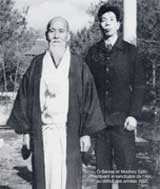1. Arts et Combats:
Saito Sensei, you spent many years with O' Sensei in Iwama.
These years constitute a key period in the development of
Aikido, could you tell us how many years Master Ueshiba taught
in Iwama?
Salto Sensel : O'
Sensei started teaching in Iwama at the end
of the 2nd World War and continued giving classes there up
to his death in 1969. In actual fact he gave his last course
at the University of Ibaraki on the lst of February 1969.
2. Arts et Combats: Did O' Sensei have many students in
Iwama?
Saito Sensei : No, at that time he didn't have many students
in Iwama. Actually, O' Sensei's students came from all over
Japan, even from places as far away as Kyushu, Akita and
Osaka. They went on to become well renowned teachers such
as Koichi Tohei Sensei and Tadashi
Abe Sensei.
3. Arts et Combats: What make up the essential modifications
that O' Sensei brought to his Aikido In Iwama?
Saito Sensei : O' Sensei changed many things. He adapted
the old techniques to make them more rational. He gave equal
priority to the relationships between the Ken, the Jo and
unarmed techniques. It was at this time that O'
Sensei finally created the Aikido that he had always hoped
to realise.
4.
Arts et C ombats: What was the most profound thing about
O' Sensel's teaching in Iwama?
Saito Sensei
: O' Sensei mastered
many different techniques that he had learnt from the ancient
schools of Jujitsu and the traditional Japanese martial arts.
He took the principal elements of these arts, classified
the techniques and accomplished the martial art of which
he had always dreamed.
5. Arts et Combats: What Importance did O' Sensei place
on the study of weapons techniques in Iwama?
Saito Sensei : O'
Sensei said that weapons techniques are identical to those
of Taijutsu (unarmed). The form and the
movements are the same. In Aikido the movements don’t
change whether one is holding a weapon or not.
6.
Arts et Combats: Sensei, could you indicate to the readers
of "Arts et Combats" the reasoning behind the Kata
taught by O' Sensel?
Saito Sensei : Everything that is used in the Kata is based
on the logic of Aikido. Aikido was
completed after the union of the Ken, the Io and the Taijutsu.
If one removes one of these elements the Aikido one achieves
is incomplete. Ail
the time that one follows the basic teachings of O' Sensei
there is no problem.
7.
Arts et Combats: Saito Sensei, in faithfully preserving
the teachings of O' Sensei, you insist much on the practice
of "Kihon" and "Ki No Nagare". Could
you speak to us about these two aspects of the practice of
Aikido?
Saito Sensei : With "Kihon" one starts on being
held, one must not start to execute the technique before
having let the grip of the partner close. Ail the basic techniques
must be practised slowly, sincerely and with precision. "Ki
No Nagare" is the logical progression on Kihon".
Thus, continuing with holds, the technique must be started
before the partner can grip solidly. In executing the technique
it is fundamental that ones movements be fluid.
8. Arts et C ombats: Did O' Sensei travel to teach in other
Dojo's ?
Saito Sensei : Yes, O' Sensei went to other Dojo's, these
were The Hombu Dojo in Tokyo and a Dojo in the district of
Kansai.
9. Arts et Combats : Was the teaching that O' Sensei gave
during these trips away different from that which he gave
in Iwama?
Saito Sensei : His teaching was no different
at these other Dojo's. Except that, in Iwama,
he took the time to correct the errors made by his disciples.
When O' Sensei travelled to teach he only went
for short periods, in the order of three days. This
is why he could only show most techniques once and didn't
have the possibility of correcting the students.
They could not learn the techniques completely. It was impossible
for them to learn the techniques in so short a time! In response
to your question however O' Sensei's teaching was exactly
the came.
10. Arts et Combats: Sensei, what did the Dojo In Iwama
mean to Master Ueshiba?
Saito Sensei : The Dojo
in Iwama was the place where O' Sensei
continued his own training in Aikido. O' Sensei built the
Aiki Jinja (temple dedicated to Aikido) in front of the Dojo.
It is there that he dedicated his life to the study of the
Way of Aikido.
Interview by Jean Paoli and translated
by Sonoko Tanaka and Daniel Toutain.
|

